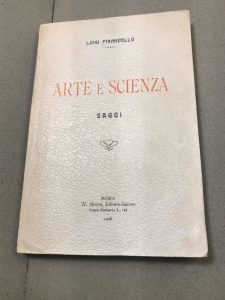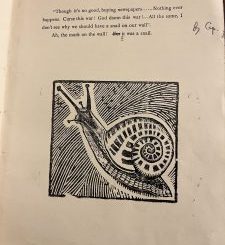Pirandello–Soggettivismo e oggettivismo nell’arte narrativa by Griffin M.
 Luigi Pirandello’s Arte e scienza is a collection of essays published in 1908. The edition in the Rubenstein was originally from the personal collection of Professor Guido Mazzoni, a poet and contemporary of Pirandello. In fact, the work is signed “a Guido Mazzoni, devotamente, Luigi Pirandello.” This personalizes the piece, as Pirandello himself gave it directly to Mazzoni. Additionally, the handwritten “Luigi Pirandello ‘Arte e scienza…’” on the book’s spine further highlights that this piece was intended for Mazzoni’s personal collection. More formal inscription techniques would be more appropriate were the book destined for a grandiose setting.
Luigi Pirandello’s Arte e scienza is a collection of essays published in 1908. The edition in the Rubenstein was originally from the personal collection of Professor Guido Mazzoni, a poet and contemporary of Pirandello. In fact, the work is signed “a Guido Mazzoni, devotamente, Luigi Pirandello.” This personalizes the piece, as Pirandello himself gave it directly to Mazzoni. Additionally, the handwritten “Luigi Pirandello ‘Arte e scienza…’” on the book’s spine further highlights that this piece was intended for Mazzoni’s personal collection. More formal inscription techniques would be more appropriate were the book destined for a grandiose setting.
Physically, the work is small: About 7.5’’ long and 5’’ wide. It is also incredibly simple. The background is a solid color, and there is minimal text and one basic design on the front and back covers. This trend continues within the book, where the designs remain simplistic and the text is only where it’s necessary.
“Soggettivismo e oggettivismo nell’arte narrativa” [Subjectivism and objectivism in narrative art] is an essay from the  book that analyzes what defines narrative art from a philosophical perspective. Essentially, Pirandello argues that narrative art is boundless, and it’s improper to put it into categories such as “realism, idealism, etc.” By doing so, the reader inherently projects preconceived ideas onto the piece and is unable to appreciate the whole of what was written. In essence, Pirandello wants the reader to analyze narratives for what is on the page rather than external considerations. The simplicity of the physical copy of Arte e scienza reaffirms this by minimizing distractions and external elaborations that may contaminate the reader’s mind.
book that analyzes what defines narrative art from a philosophical perspective. Essentially, Pirandello argues that narrative art is boundless, and it’s improper to put it into categories such as “realism, idealism, etc.” By doing so, the reader inherently projects preconceived ideas onto the piece and is unable to appreciate the whole of what was written. In essence, Pirandello wants the reader to analyze narratives for what is on the page rather than external considerations. The simplicity of the physical copy of Arte e scienza reaffirms this by minimizing distractions and external elaborations that may contaminate the reader’s mind.
Pirandello published “The Trip” in 1910, just two years after Arte e scienza. The fictional story describes a widow, Adrianna, and her travels after doctors tell her that she is terminally ill. Aside from the close temporal relationship between the two, “The Trip” serves as a microcosm of the message inherent in “Soggettivismo e oggettivismo nell’arte narrativa.” Adrianna initially lives within the societal bubble/expectations for her as a woman, wife, and eventually widow. In this setting, her life seems unhappy due to her unfortunate marriage and malady. But, when she breaks out of the societal boundaries, she finds herself “young and beautiful. A new person!” Later on, during her trip, she feels “life, life, only life violently entering her soul.” This sudden freedom, liberation, and passion as Adrianna breaks away from societal constraints reflects the sentiment that Pirandello shares in his essay that argues that narrative art, too, is boundless and cannot follow preconceived rules or expectations. In short, Adrianna’s abandonment of custom is an example of the beauty in leaving behind external considerations, and her trip is an art form in and of itself.











Recent Comments